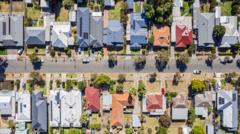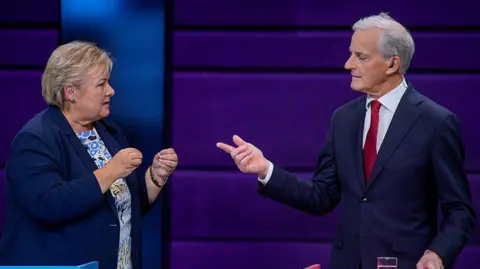In the lead-up to the federal election, Australia finds itself grappling with a severe housing crisis that has rendered homeownership and rental affordability nearly out of reach for the average citizen. With less than a month until Australians cast their votes, the housing issue has emerged as a crucial topic, with both dominant political factions—the Labor Party and the Liberal-National Coalition—vowing to address the crisis through various initiatives.
Real estate prices have surged to dizzying heights, exacerbated by rising living costs and the looming impact of international economic pressures, including trade tensions linked to former U.S. President Donald Trump's policies. The promise of returning to a more accessible housing market remains to be seen amid a web of unfulfilled aspirations.
Australia's failure to construct adequate housing for its burgeoning population is the crux of the crisis. A stark imbalance between housing supply and demand has created a situation with limited viable options, pushing property values higher. Planning regulations have exacerbated the issue by restricting development in preferred metropolitan areas, leading to a shortage of housing in densely populated cities like Sydney and Melbourne, which remain sparsely developed compared to other global metropolises.
The decline in public housing availability and the increasing backlog for social assistance have intensified homelessness and crowded living situations, while the effects of climate change have rendered some regions nearly uninhabitable following destructive natural disasters. Additionally, decades of government focus on property as an investment rather than a right have further complicated the situation, turning the aspiration to homeownership into an often unattainable dream.
Currently, buying a home in Sydney has reached such extremes that it ranks as the second least affordable city globally to purchase real estate, with an average price tag nearing A$1.2 million. Nationwide data showcases that average house prices have surged by nearly 40% in the past five years, while wage growth has failed to keep pace, prolonging the time needed for prospective homeowners to amass requisite deposits.
The rental market provides little reprieve, with recent trends indicating a 36% national increase in rents since the onset of the COVID-19 pandemic, translating to an additional A$171 in weekly expenses for renters. Sydney leads the pack in rental prices, further burdening its residents.
While government-level discussions often cite immigration and foreign investment as primary culprits contributing to the housing dilemma, experts argue that their actual influence on the housing market is negligible. A significant portion of migrants does not enter the housing market, residing instead in student accommodations, flouting claims that foreign buyers dramatically impact local housing demands.
In response to the crisis, both major parties have submitted contrasting proposals. Labor aims to construct 1.2 million new homes by 2029 with a substantial A$33 billion investment, while the Coalition proposes unlocking 500,000 homes and emphasizes curtailing immigration and establishing infrastructure support. The Greens advocate for rental stability through caps and freezes and prioritize reforming investor tax incentives amid calls for a more sustainable housing future.
Expert opinion reveals a consensus that, despite both major party proposals representing positive steps, they fall short of comprehensively addressing the multi-faceted housing crisis. Predictions indicate that even ambitious goals may not meet the rampant demand, and proposed immigration cuts could hinder economic momentum in the long term.
As Australia braces for electoral decisions, the urgency surrounding its housing crisis highlights an impending reckoning—one that demands transformative measures to reverse years of stagnation in public housing investment and policy failure. The national conversation now leans toward ensuring a more equitable future for all in the housing market.
Real estate prices have surged to dizzying heights, exacerbated by rising living costs and the looming impact of international economic pressures, including trade tensions linked to former U.S. President Donald Trump's policies. The promise of returning to a more accessible housing market remains to be seen amid a web of unfulfilled aspirations.
Australia's failure to construct adequate housing for its burgeoning population is the crux of the crisis. A stark imbalance between housing supply and demand has created a situation with limited viable options, pushing property values higher. Planning regulations have exacerbated the issue by restricting development in preferred metropolitan areas, leading to a shortage of housing in densely populated cities like Sydney and Melbourne, which remain sparsely developed compared to other global metropolises.
The decline in public housing availability and the increasing backlog for social assistance have intensified homelessness and crowded living situations, while the effects of climate change have rendered some regions nearly uninhabitable following destructive natural disasters. Additionally, decades of government focus on property as an investment rather than a right have further complicated the situation, turning the aspiration to homeownership into an often unattainable dream.
Currently, buying a home in Sydney has reached such extremes that it ranks as the second least affordable city globally to purchase real estate, with an average price tag nearing A$1.2 million. Nationwide data showcases that average house prices have surged by nearly 40% in the past five years, while wage growth has failed to keep pace, prolonging the time needed for prospective homeowners to amass requisite deposits.
The rental market provides little reprieve, with recent trends indicating a 36% national increase in rents since the onset of the COVID-19 pandemic, translating to an additional A$171 in weekly expenses for renters. Sydney leads the pack in rental prices, further burdening its residents.
While government-level discussions often cite immigration and foreign investment as primary culprits contributing to the housing dilemma, experts argue that their actual influence on the housing market is negligible. A significant portion of migrants does not enter the housing market, residing instead in student accommodations, flouting claims that foreign buyers dramatically impact local housing demands.
In response to the crisis, both major parties have submitted contrasting proposals. Labor aims to construct 1.2 million new homes by 2029 with a substantial A$33 billion investment, while the Coalition proposes unlocking 500,000 homes and emphasizes curtailing immigration and establishing infrastructure support. The Greens advocate for rental stability through caps and freezes and prioritize reforming investor tax incentives amid calls for a more sustainable housing future.
Expert opinion reveals a consensus that, despite both major party proposals representing positive steps, they fall short of comprehensively addressing the multi-faceted housing crisis. Predictions indicate that even ambitious goals may not meet the rampant demand, and proposed immigration cuts could hinder economic momentum in the long term.
As Australia braces for electoral decisions, the urgency surrounding its housing crisis highlights an impending reckoning—one that demands transformative measures to reverse years of stagnation in public housing investment and policy failure. The national conversation now leans toward ensuring a more equitable future for all in the housing market.





















